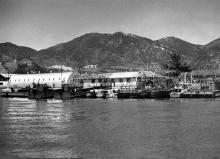Who dug the Japanese tunnels?
Primary tabs
Here's a page to gather any references to who dug them. First up is a mention in James Hayes' book, "The Great Difference. Hong Kong's New territories and its People 1898-2004":
Labour requirements for Military Works
The local self-governing offices were expected to respond to Japanese demands for assistance of varied kinds. In Tsuen Wan and Sai Kung, the most notable was for labour to construct access roads to the Japanese wireless station on Tai Mo Shan and from Clear Water Bay into Sai Kung. labour was also required in places like Mui Wo (Lantau) and Lamma Island to make tunnels and caves for coastal observation and defence. Villagers said that conscription was not applied, even though many hands were required and reported gangs of over 100 workers. Men, women and children were glad to come forward, for the sake of the rice that was doled out in lieu of cash payments. "One scoop for us men, and half for women and child workers", as one of the Tsuen Wan villagers recalled. The Sia Kung experience was similar.


Comments
Building the tunnels
I see from my "Synopsis of narrative written by Miss M.M. Baird for Kirby's "The War Against Japan" Vol.I [PRO CAB 101/199]" that she twice mentions the building of tunnels.
"In 1945 parties were sent out of camp [SSPo] to dig tunnels." and "During 1945 rations deteriorated and there was a steady slipping back in the health of the main (other ranks) camp, a situation which was not improved by the demands made for large working parties to dig tunnels outside the camp".
POWs Digging Tunnels
Another source here supports the fact that POWs dug many tunnels in Hong Kong.
From memories uninvited : https://www.hkvca.ca/memoriesuninvited/Chapter%208.php
"The work site was a very dangerous place to be. The ground was soft and easy to dig, but for that reason the tunnels were very unstable. A cave-in could happen at any time. Fortunately only one serious accident happened when Harry Irvine's leg was broken when the roof caved in on him.
Some of us were sent out to cut trees for props to shore up the tunnels. On the grounds of the University of Hong Kong, with primitive Japanese saws that cut on the pull stroke, we cut some beautiful ornamental trees and hauled them back to the work site.
The logs were bound together and erected at the mouth of the tunnel in a ramshackle frame. It didn't look very professional and no doubt would not have been very effective in the event of a cave-in.
The tunnels went straight into the hill for about thirty feet, then drifted to one side at ninety degrees for another twenty or so feet, then straight in again.
The purpose of this zig-zag pattern was probably meant to confuse any intruder, but the effect on us diggers was nothing less than uncomfortable and very dangerous.
Conditions at the end of the tunnel were bad. It was hot and there was very little air. Five minutes there was the most a man could take."
re: POWs Digging Tunnels
That's a good addition, thank you!
When I read this I thought perhaps they were digging somewhere near to HKU:
On the grounds of the University of Hong Kong, with primitive Japanese saws that cut on the pull stroke, we cut some beautiful ornamental trees and hauled them back to the work site.
But earlier he writes:
I was deemed fit to work, and so joined the group of tunnellers who went out daily to dig in the side of the mountain.
We left ShamShuiPo in the morning in darkness and marched to work, some two or threes miles, there to dig tunnels in the side of the hills. From what information we could get out of the Japs, the purpose of the tunnels was to store food supplies, and to act as defence positions in the event of an American invasion.
So he was digging in Kowloon. Perhaps he was one of the men who dug the tunnels at DBS: https://gwulo.com/japanese-tunnels-diocesan-boys-school-hong-kong